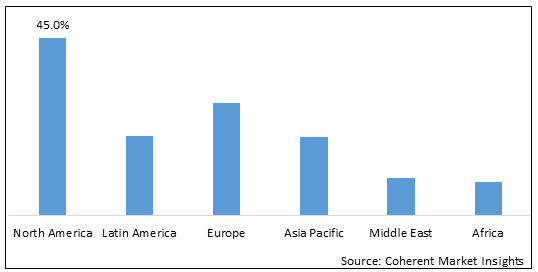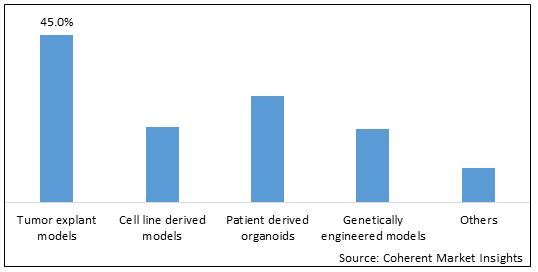Patient Derived Xenograft Model Market is estimated to be valued at USD 147.4 Mn in 2025 and is expected to reach USD 483.6 Mn in 2032, exhibiting a compound annual growth rate (CAGR) of 18.5% from 2025 to 2032. Patient-derived xenograft (PDX) models are developed by implanting patient tumor samples into immunodeficient mice. These models retain the principal histopathological and genetic characteristics of their originating tumors and are emerging as a clinically relevant cancer model for cancer research and precision medicines. The increasing use of PDX models in preclinical oncology research and personalized medicine is a major factor driving the market growth.
The Patient Derived Xenograft Model Market is segmented by model type, implantation method, tumor type , end user and region. By model type, the market is segmented into Tumor explant models, Cell line derived models, Patient derived organoids, genetically engineered models and others. Tumor explant models accounted for the largest share of the Patient Derived Xenograft Model Market in 2022.
Patient Derived Xenograft Model Market Regional Insights:
- North America is expected to be the largest market for Patient Derived Xenograft Model Market during the forecast period, accounting for over 34.2% of the market share in 2025. The growth of the market in North America is attributed to the high adoption rate of PDX models in preclinical and translational research, increasing government funding for cancer research, and presence of leading PDX model providers in the region.
- The Europe market is expected to be the second-largest market for Patient Derived Xenograft Model Market, accounting for over 27.8%% of the market share in 2025. The growth of the market in Europe is attributed to the rising incidence of cancer, well-developed healthcare research infrastructure, and increasing focus on personalized medicine in the region.
- The Asia Pacific market is expected to be the fastest-growing market for Patient Derived Xenograft Model Market, with a CAGR of over 21.7% during the forecast period. The growth of the market in Asia Pacific is attributed to the improving R&D infrastructure, increasing pharmaceutical R&D investments, and growing focus on developing better cancer therapies in the region.
Figure 1. Global Patient Derived Xenograft Model Market Share (%), by Region, 2025

To learn more about this report, Download Free Sample
Analyst View
- The global patient derived xenograft model market appears promising over the next decade. Driven by rising investments in cancer research and growing demand for personalized medicine, the adoption of PDX models is expected to increase significantly. As drug developers strive to improve clinical success rates, PDX models are emerging as a valuable tool due to their ability to mimic human tumor behavior and predict therapy response with high accuracy. Additionally, as biomarker-driven drug development gains centerstage, the potential of PDX models to validate biomarkers and critical pathways involved in a patient's response makes them an attractive option for pharma companies
Patient Derived Xenograft Model Market Drivers:
- Increasing Cancer Research: The rising prevalence of cancer globally is driving research initiatives to develop novel anti-cancer drugs and therapies. PDX models are increasingly being used in preclinical and translational oncology research to understand tumor behavior, identify predictive biomarkers, and evaluate drug efficacy. The continuity of molecular and histopathological characteristics from the patient tumor to PDX model enables precise recapitulation of tumor biology and treatment responses. Moreover, the high failure rates of oncology drugs in clinical trials have further augmented the adoption of translational PDX models earlier in drug discovery to improve clinical predictability.
- Advancements in PDX Model Generation: Continuous advancements in PDX model generation, such as direct transfer techniques, three-dimensional grafting methods, and co-engraftment of human stromal components, have improved tumor engraftment rates and enabled development of robust PDX platforms. Advancements in imaging, microscopy, and tissue analytic techniques have enhanced characterization and molecular profiling capabilities of PDX models. This has expanded the applications of PDX models in biomarker identification, drug screening, and personalized therapy selection.
- Increasing Adoption of Personalized Medicine: The shift towards precision medicine and targeted therapies has amplified the demand for patient-centric disease models. PDX models enable identification of therapies tailored to the molecular profiles of individual patients’ tumors. Pharma companies have integrated PDX models and OMICs technologies into co-clinical trials to adapt treatments in real-time based on PDX-guided drug response data. Several research consortiums have been launched to expand PDX-driven personalized medicine programs.
Patient Derived Xenograft Model Market Opportunities:
- Applications in Immunotherapy Testing: The emergence of immune checkpoint inhibitors and CAR T-cell therapies has created lucrative opportunities for PDX models in cancer immunotherapy research. PDX models developed using humanized mice that retain human immune system components are gaining traction in immuno-oncology applications.
- Use of PDX Models in Drug Repurposing: The high costs of new oncology drug development have prompted interest in repurposing existing drugs for cancer treatment. PDX models enable cost-effective screening of libraries of approved drugs.
- Rising Industry-Academia Collaborations: Increasing collaborations between pharma/biotech firms and academic institutions to accelerate PDX-based oncology research are creating new growth avenues.
- Adoption in Clinical Practice: The clinical validity of PDX models has led to their gradual adoption in guiding therapeutic decisions for cancer patients, especially those with rare or aggressive tumors. For instance, the Prospective Validation of Predictive Platinum-based PDX Clinical Trial is an ongoing clinical study testing PDX model-guided therapies in lung cancer patients. The integration of PDX models into standard clinical practice represents an important opportunity area.
Patient Derived Xenograft Model Market Report Coverage
| Report Coverage | Details | ||
|---|---|---|---|
| Base Year: | 2024 | Market Size in 2025: | USD 147.4 Mn |
| Historical Data for: | 2020 To 2024 | Forecast Period: | 2025 To 2032 |
| Forecast Period 2025 to 2032 CAGR: | 18.5% | 2032 Value Projection: | USD 483.6 Mn |
| Geographies covered: |
|
||
| Segments covered: |
|
||
| Companies covered: |
THE JACKSON LABORATORY, Champions Oncology, Inc, Charles River Laboratories, Crown Bioscience, Hera Biolabs, Horizon Discovery Ltd., Oncodesign, Pharmatest Services, Shanghai LIDE Biotech, Aragen Life Sciences Ltd., Creative Animodel, Urosphere, Applied StemCell and WuXi AppTec |
||
| Growth Drivers: |
|
||
| Restraints & Challenges: |
|
||
Uncover macros and micros vetted on 75+ parameters: Get instant access to report
Patient Derived Xenograft Model Market Trends:
- Integration with OMICs Technologies: The pairing of PDX models with genomic, transcriptomic and proteomic profiling technologies is enabling in-depth molecular characterization and biomarker discovery. Companies like Crown Bioscience and Champions Oncology offer integrated PDX-OMICs platforms combining drug efficacy testing with multi-omics analysis on PDX models. The development of PDX biobanks with comprehensive omics datasets will facilitate biomarker validation and personalized therapy development.
- Consortium-based PDX Model Development: Oncology researchers are collaborating to build large PDX collections through consortiums representing multiple cancer types. The EurOPDX, Paediatric Preclinical Proof of Concept platform, and PRISM PDX Development Consortium are examples of collaborative PDX networks expanding model access for academia and industry. The collective approach to PDX generation leverages expertise across research centers and enhances standardization.
- Development of Next-generation PDX Technologies: Emerging PDX technologies, such as 3D-bioprinted tumor models and organoid-PDX hybrids, are garnering interest from cancer researchers. For instance, the HuPrime PDX model developed by Horizon Discovery enables co-engraftment of human stromal components along with patient tumors. Adoption of novel techniques to improve engraftment, personalized relevance, and molecular fidelity of PDX models will support market growth.
Patient Derived Xenograft Model Market Restraints:
- Limitations of PDX Models: While PDX models demonstrate clinical relevance, they have certain limitations in recapitulating human tumor biology and morphology. The models lack an intact immune system and do not portray tumor-immune interactions or metastatic potential. Variability in engraftment success across patient samples and gradual loss of human stroma remain key challenges. Addressing these limitations is critical to expand PDX applications.
- Lack of Standardization: The lack of standardized procedures for PDX generation, propagation, molecular analysis, and data interpretation limits reproducibility across models and laboratories. Variability in human stroma loss, mouse strains used, number of passages, and data analysis precludes direct comparisons between PDX lines. Developing standardized best practices through global harmonization efforts will be key.
- Ethical Concerns Related to Animal Welfare: Despite regulatory oversight, the use of immunosuppressed animals to generate PDX models raises ethical concerns regarding pain and distress. Advancing 3D-based in vitro tumor models and organoid-PDX hybrids may circumvent extensive animal usage for certain applications. However, in vivo PDX models currently remain integral to recapitulating tumor complexity. Implementation of stringent animal welfare policies can help address ethical concerns.
Recent Developments:
- In July 2022, GemPharmatech (GemPharmatech Co., Ltd.) announced that it has entered into a strategic licensing agreement with Charles River Laboratories, Inc. for the exclusive distribution of its next-generation NOD CRISPR Prkdc Il2r Gamma (NCG) mouse lines in North America . Charles River will build foundation colonies with models scheduled to be commercially available in 2023.
- In April 2022, Professor Kamimura's research group at Niigata University established a novel pancreatic carcinogenesis model in wild-type rats using the pancreas-targeted selective hydrodynamic gene delivery method. Source:
Figure 2. Global Patient Derived Xenograft Model Market Share (%), by Model Type, 2025

To learn more about this report, Download Free Sample
Top companies in Patient Derived Xenograft Model Market:
- THE JACKSON LABORATORY
- Champions Oncology, Inc
- Charles River Laboratories
- Crown Bioscience
- Hera Biolabs
- Horizon Discovery Ltd.
- Oncodesign
- Pharmatest Services
- Shanghai LIDE Biotech
- Aragen Life Sciences Ltd.
- Creative Animodel
- Urosphere
- Applied StemCell
- WuXi AppTec
Definition: The patient-derived xenograft (PDX) model market refers to the market for human tumor models developed by implanting patient tumor samples into immunocompromised mice. PDX models retain the principal histopathological and genetic characteristics of their originating tumors. They are clinically relevant tumor models that can accurately predict the efficacy of anticancer drugs. PDX models are used for preclinical cancer research, biomarker identification, personalized medicine, and therapeutic applications. They help in understanding tumor biology, identifying predictive biomarkers, screening drug candidates, and providing personalized therapeutic options. The global PDX model market is driven by the growing demand for personalized cancer therapies and increasing cancer research. PDX models are commercially available through contract research organizations or can be custom-developed using patient tumor samples. Key players provide integrated PDX platforms and services to accelerate oncology drug discovery and development.
Few Other Promising Reports in Biotechnology Industry
Share
Share
About Author
Abhijeet Kale is a results-driven management consultant with five years of specialized experience in the biotech and clinical diagnostics sectors. With a strong background in scientific research and business strategy, Abhijeet helps organizations identify potential revenue pockets, and in turn helping clients with market entry strategies. He assists clients in developing robust strategies for navigating FDA and EMA requirements.
Missing comfort of reading report in your local language? Find your preferred language :
Transform your Strategy with Exclusive Trending Reports :
Frequently Asked Questions
Select a License Type
EXISTING CLIENTELE
Joining thousands of companies around the world committed to making the Excellent Business Solutions.
View All Our Clients




